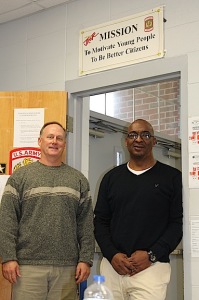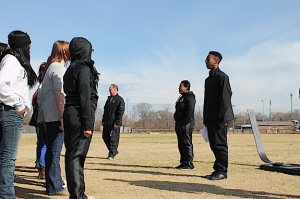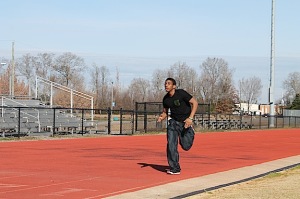JROTC program goes beyond military aspirations

Teaching JROTC involves more than the history and organization of the military. It covers more than physical training and marching.
At least it does to the two instructors at Demopolis High School.
Maj. Don Drummond and 1SG Rhuel Pringle are mentors and counselors in addition to being teachers to the some 115 students in their JROTC classes, including two dozen seniors. They consider their jobs a success if the young men and women follow the mission statement posted above the classroom door: “To motivate young people to be better citizens.”
Students elect to take JROTC for any number of reasons, said the two.
“I think some of them are intrigued,” said Pringle. “It’s new to them. They don’t know what it’s about. And then we get some a majority of them that it’s going to fall right into their future plans.”
“Most join because they like the structure of it. We don’t do lecture 50 minutes every day,” said Drummond.
Pringle, who hails from Sumter, S.C., added, “We’re not recruiters, but we do make it known that since we spent over half our life in the military, that it’s a great option.”
“I think people have a pre-conceived notion that if you join JROTC you have aspirations of going into the military, and that’s not true,” Drummond said. “We try to put some structure in their lives and let them know that we care about them.”
“The military would be a good structure for them, a good beginning,” added Pringle. They can be molded into great adults with some help along the way. “You’re not going to save everybody, but we’re giving it our best try”

“I knew when I first got here I wasn’t going to be able to save all the kids, and that’s one of the things that’s kind of hard to accept,” Drummond said. “But then the ones that come back and say ‘I appreciate you not giving up on me,’ those success stories are why you do it. That’s what keeps you in this type of environment.”
They stress discipline, even requiring students to sign a contract spelling out grooming requirements that must be met.
“We’re here for them, not to work against them,” and they come to realize it, Drummond continued.
Both instructors encourage students to look to their future after high school. Drummond especially urges the seniors to set a plan and decide their goals and objectives and decide what they really want to do.
In the classroom the instructors follow the course of study as set by the State of Alabama. They begin with the basics on the history of the flag and its colors, how to fold it, basic military structure, staffing and ranks.

But the classes do more than stretch the mind. Physical training is held on Thursdays, and Fridays are devoted to sports and team building exercises.
Both instructors have had to earn certificates to teach in Alabama, but both have had extensive experience in teaching while serving in the military.
Drummond, a Eutaw native who retired in 2005 after 20 years of service, is in his fourth year at DHS. Pringle joined the staff in November. He retired from the Army after 26 years on active duty.
Drummond said some 1,700 schools across the nation have a JROTC program, and 90 percent of those students go on to further their education. At DHS 10-12 percent choose to enter the military.
Those who enlist after two years in JROTC automatically enter as an E2. If they have had four years, then they enter as an E3, which is a huge difference in pay, the two said.
Drummond welcomes back former students who have joined one of the services. “I always invite them back (to) talk to the students about their experiences and what they’ve learned and how it’s impacted their life and what JROTC has meant to them.”
The JROTC program offers extra-curricular activities for the students who want to take part. In November a group of them competed in a physical training course with other units in the area. Two of the women students returned home with first and second place in PT.
Uniforms are provided for all those who want to take part in marching units or as part of the competitive drill team.
The team is gearing up to face all other schools in the district this spring. Drummond is stressing that the cadets of DHS are every bit as good as those in larger schools.
“Some would wear the uniform every day if they could,” said Pringle. “Then we get some that won’t even wear it that one day.”
JROTC requires a minimum of 75 students enrolled in the courses. If the numbers reach 150, the school would have to add another instructor.
As part of the focus on citizenship, the cadets hold a canned food drive before Thanksgiving, which is always a success, said Drummond, and they have adopted a mile of highway to keep litter free.
In the spring all of the students will take part in a Cadet Challenge. The five events let the students know where they are in strength and conditioning.
This story is part of a series highlighting the career tech programs at Demopolis High School. The series will appear on Sundays throughout February in honor of Career Tech Month.
